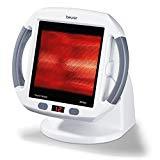Ah, the office worker’s & the wrestler’s chronic ailment – a stiff neck.
The stiff neck is underrated in its ability to ruin your day. It often leads of headaches and can definitely put you in a really terrible mood.
Jokes aside, physical issues such as an injured neck, can cause mental health problems. I kid you not. This study on whiplash for example, suggests some people may have depression for several associated reasons – including neck injuries. Not conclusive evidence but from experience, I think there may be some truth to the theory that neck injuries make you miserable.
I mention this, because the one time that I had whiplash, I also had bad anxiety afterwards, along with headaches and bloodshot eyes – for several months.
As I worked out how to treat my neck, my mood improved and the headaches went away.
Anyway, enough of the preamble, here’s some ways to treat a stiff neck.
Use Heat to Treat a Stiff Neck
Any application of heat, should help with a muscle spasm. In fact, after my car crash, I found that applying a hot water bottle to my neck whenever possible, was very helpful.
There are better ways though…
Infrared Lamp or Infrared Sauna for Muscle Spasms

I completely forgot about this when I made the video above.
From what I understand, infrared light penetrates relatively far/deep into a muscle, causing it to relax more than is normally possible with a normal sauna, bath or other application of ‘conventional’ heat.
The last time I injured/hurt my neck was about 2 months ago. I couldn’t sleep and even got a prescription for codeine, even though I’m normally against any pharma-pain-killers.
I had tried hot baths, but the relief was only temporary.
Then I tried an infrared lamp on my neck (with magnesium oil rubbed it before use), and my mood instantly lifted, as the stiffness in my neck subsided. My neck/lower trapezius was still painful, but I’d regained full range of motion.
This study shows that infrared light can be used to effectively treat lower back pain:
Infrared therapy for chronic low back pain: A randomized, controlled trial
George D Gale, MBBS FRCA FRCPC DAAPM,1 Peter J Rothbart, MD FRCPC,1 and Ye Li2CONCLUSION
The IR therapy unit used was demonstrated to be effective in reducing chronic low back pain, and no adverse effects were observed.
As I write this, I’m currently using an infrared lamp on my neck. I bought it from Amazon.co.uk and would recommend it for muscle-spasm-related neck pain.
TENS Machine
A TENS machine is an interesting device.
They’re similar to those old electrocuting and are used as an alternative form of pain relief during child birth.
They can also help to remove muscle spasms.
Pretty good for the pain, but this alone, didn’t get rid of the stiffness & spasm in my neck.
Magnesium
One of the most underrated supplements, it’s estimated that around 50% of Americans are deficient in magnesium.
Important for muscle relaxation in general, supplementation has been shown to treat insomnia, depression & anxiety.
Role of magnesium supplementation in the treatment of depression: A randomized clinical trial Emily K. Tarleton1
*, Benjamin Littenberg1,2
, Charles D. MacLean1,2‡, Amanda G. Kennedy1,2‡, Christopher Daley3‡
Consumption of magnesium chloride for 6 weeks resulted in a clinically significant net improvement in PHQ-9 scores of -6.0 points (CI -7.9, -4.2; P<0.001) and net improvement in Generalized Anxiety Disorders–
So back to the neck issues – magnesium is one of the best (& safest) muscle relaxants. The potency appears to differ massively between forms of magnesium & manufacturers. Glycinated forms of magnesium are generally recommended for muscle stiffness/spasm, taken at night.
Other effective, natural, muscle relaxants include:
- Kava Kava
- Chamomile
- Lemon Balm
- Beer
Kundalini Yoga
This particular practice was designed to release tension in the muscles surrounding the spine.
It’s pretty low-intensity, but be warned that lots of people report hallucinating after doing Kundalini Yoga (including my wife & I).
PNF & PMR
PNF stretching involves tensing the muscles for 30 seconds (or resisting/pushing with a specific set of muscles), and then relaxing & stretching immediately afterwards.
This can be modified for the neck muscles, and can be quite effective for relaxation and general awareness
Trigger Point Therapy
This requires a foam roller or preferably a ball, like a cricket or lacrosse ball.
Lie on the floor and place the ball underneath the tight muscle. Then just lay back and put pressure on the ball for 30 seconds to 1 minute.
This (sometimes) takes the spasm out of the muscle.

